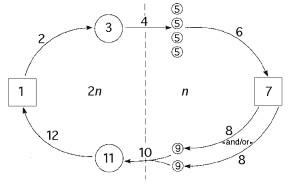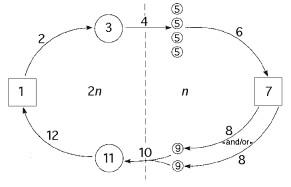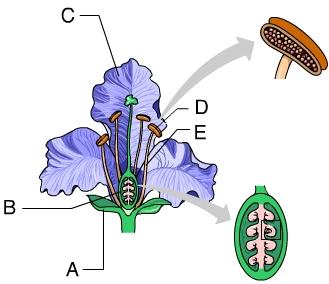Instructions for Side by Side Printing
- Print the notecards
- Fold each page in half along the solid vertical line
- Cut out the notecards by cutting along each horizontal dotted line
- Optional: Glue, tape or staple the ends of each notecard together
Chapter 30: Seed Plants
front 1 Which part of a plant attracts pollinators? Petals Carpel Stamen Sepal | back 1 Petals |
front 2 Which process involves the transfer of pollen grains from an anther to a stigma? Fertilization Gametogenesis Pollination Germination | back 2 Pollination |
front 3 True or false? The endosperm in a seed develops into the embryo. | back 3 False |
front 4 Which term describes the male gametophytes of flowering plants? Megaspores Pollen grains Micropyle Microsporocytes | back 4 Pollen Grains |
front 5 Which structure formed by the male gametophyte allows sperm to reach the ovary of a flowering plant? Pollen tube Stigma Anther Micropyle | back 5 Pollen Tube |
front 6 How is fertilization in flowering plants different from fertilization in other plant groups? Two sperm nuclei fuse with a polar nucleus to form a diploid zygote. One sperm nucleus fuses with the egg to form a diploid zygote. One sperm nucleus fuses with the egg to form a diploid zygote, whereas the other sperm nucleus fuses with a polar nucleus to form a diploid cell that forms a nutrient-rich tissue. One sperm nucleus fuses with the egg to form a diploid zygote, whereas the other sperm nucleus fuses with two polar nuclei to form a cell that develops into endosperm. | back 6 One sperm nucleus fuses with the egg to form a diploid zygote, whereas the other sperm nucleus fuses with two polar nuclei to form a cell that develops into endosperm. |
front 7 Which of the following statements about seed formation in a flowering plant is true? The basal cell formed from mitosis of the zygote divides to form a globular mass that is the route for nutrient transfer to the developing embryo. The terminal cell formed from mitosis of the zygote divides to form a row of single cells that eventually forms the embryo. Hypocotyls are the seed leaves of the embryonic plant. The swellings that develop into cotyledons are located at the end of the embryo on top of the row of single cells. | back 7 The swellings that develop into cotyledons are located at the end of the embryo on top of the row of single cells. |
front 8 When you look at a pine or maple tree, the plant you see is a _____. diploid gametophyte triploid endosperm haploid gametophyte haploid sporophyte diploid sporophyte | back 8 diploid sporophyte |
front 9 All seed plants _____. exhibit a dominant gametophyte generation produce antheridia and archegonia on the same gametophyte produce flowers are nonvascular are heterosporous | back 9 are heterosporous |
front 10 In addition to seeds, which of the following characteristics is unique to the seed-producing plants? pollen megaphylls use of air currents as a dispersal agent sporopollenin lignin present in cell walls | back 10 Pollen |
front 11  The following question refers to the generalized life cycle for land
plants shown in the figure. Each number within a circle or square
represents a specific plant or plant part, and each number over an
arrow represents either meiosis, mitosis, or fertilization. 2 and 8 4 and 8 2 4 10 and 12 | back 11 4 |
front 12  The following question refers to the generalized life cycle for land
plants shown in the figure. Each number within a circle or square
represents a specific plant or plant part, and each number over an
arrow represents either meiosis, mitosis, or fertilization. fertilization. mitosis. binary fission. meiosis. nuclear fission. | back 12 mitosis |
front 13 Which of the following statements correctly describes a portion of the pine life cycle? Female gametophytes use mitosis to produce eggs. Seeds are produced in pollen-producing cones. A pollen tube slowly digests its way through the triploid endosperm. Pollen grains contain female gametophytes. | back 13 Female gametophytes use mitosis to produce eggs. |
front 14 Within a gymnosperm megasporangium, what is the correct sequence in which the following should appear during development, assuming that fertilization occurs? 1. sporophyte embryo | back 14 Megaspore Female Gametophyte egg cell sporophyte embryo |
front 15 Arrange the following structures, which can be found on male pine
trees, from the largest structure to the smallest structure (or from
most inclusive to least inclusive). | back 15 Sporophyte Pollen Cone Microsporangia Microspores Pollen nuclei |
front 16 Reptilian embryos are protected from desiccation by a leathery shell. Similarly, which pair of structures protects seed plants' embryos and male gametophytes, respectively, from desiccation? integuments–sporopollenin ovaries–filaments ovules–waxy cuticle fruits–stamens pollen grains–waxy cuticle | back 16 integuments–sporopollenin |
front 17 Which of the following sex and generation combinations most directly produces the pollen tube? female gametophyte male sporophyte male gametophyte female sporophyte | back 17 male gametophyte |
front 18 Which of the following sex and generation combinations most directly produces the fruit? male gametophyte male sporophyte female gametophyte female sporophyte | back 18 female sporophyte |
front 19  Ovules are found within structure _____. A B C D E | back 19 B |
front 20 Which of these is unique to flowering plants? haploid gametophytes an embryo surrounded by nutritive tissue pollen production double fertilization a dominant sporophyte generation | back 20 double fertilization |
front 21 The male gametophytes of flowering plants are also referred to as _____. endosperm male sporophytes pollen grains embryo sacs megaspores | back 21 Pollen grains |
front 22 In flowering plants the integuments of the ovule develop into a(n) _____. cotyledon sporophyte fruit seed coat endosperm | back 22 seed coat |
front 23 A carpel is composed of _____. ovule, megasporocyte, and anther ovary, ovule, and anther stigma, style, and ovary zygote, anther, and endosperm petal, sepal, and stamen | back 23 stigma, style, and ovary |
front 24 A stamen consists of _____. anther and filament stigma and anther ovary and sepal stigma and filament stigma and style | back 24 anther and filament |
front 25 In angiosperms, pollination is the transfer of pollen grain to the _____ of a flower on the same plant or another plant of the same species. ovary stigma style ovulate cone anther | back 25 Stigma |
front 26 Angiosperms are different from all other plants because only they have _____. flowers a sporophyte phase a life cycle that involves alternation of generations a vascular system seeds | back 26 Flowers |
front 27 Unlike most angiosperms, grasses are pollinated by wind. As a consequence, some unnecessary parts of grass flowers have almost disappeared. Which of the following parts would you expect to be most reduced in a grass flower? petals stamens anthers ovaries carpels | back 27 Petals |
front 28 The Brazil nut tree, Bertholletia excels (n = 17), is native
to tropical rain forests of South America. It is a hardwood tree that
can grow to over 50 meters tall, is a source of high-quality lumber,
and is a favorite nesting site for harpy eagles. As the rainy season
ends, tough-walled fruits, each containing 8-25 seeds (Brazil nuts),
fall to the forest floor. Brazil nuts are composed primarily of
endosperm. About $50 million worth of nuts are harvested each year.
Scientists have discovered that the pale yellow flowers of Brazil nut
trees cannot fertilize themselves and admit only female orchid bees as
pollinators. The agouti (Dasyprocta spp.), a cat-sized
rodent, is the only animal with teeth strong enough to crack the hard
wall of Brazil nut fruits. It typically eats some of the seeds, buries
others, and leaves still others inside the fruit, which moisture can
now enter. The uneaten seeds may subsequently germinate. | back 28 4, 2, 3, 1 |
front 29 Which of the following sex and generation combinations directly produces the pollen tube of angiosperms? female gametophyte male sporophyte male gametophyte female sporophyte | back 29 male gametophyte |
front 30 In gymnosperms megaspores develop into _____ . male gametophytes female gametophytes ovulate cones female sporophytes pollen grains | back 30 female gametophytes |
front 31 Which of the following directly produces the fruit of angiosperms? pollen tube male gametophyte female gametophyte ovary | back 31 Ovary |
front 32 Human survival literally depends on the produce of _____. gymnosperms angiosperms cycads ginkgoes gnetophytes | back 32 angiosperms |
front 33 The Brazil nut tree, Bertholletia excels (n = 17),
is native to tropical rain forests of South America. It is a hardwood
tree that can grow to over 50 meters tall, is a source of high-quality
lumber, and is a favorite nesting site for harpy eagles. As the rainy
season ends, tough-walled fruits, each containing 8-25 seeds (Brazil
nuts), fall to the forest floor. Brazil nuts are composed primarily of
endosperm. About $50 million worth of nuts are harvested each year.
Scientists have discovered that the pale yellow flowers of Brazil nut
trees cannot fertilize themselves and admit only female orchid bees as
pollinators. The agouti (Dasyprocta spp.), a cat-sized
rodent, is the only animal with teeth strong enough to crack the hard
wall of Brazil nut fruits. It typically eats some of the seeds, buries
others, and leaves still others inside the fruit, which moisture can
now enter. The uneaten seeds may subsequently germinate. clear-cutting forests containing Brazil nut trees to make way for crops with proven medical benefits better education for the native peoples so that they will overcome their old ways an increase in the living standards of the native peoples so that they might be able to purchase modern pharmaceuticals the evaluation of Brazil nut chemicals for use as potential drugs | back 33 the evaluation of Brazil nut chemicals for use as potential drugs |